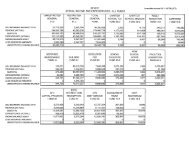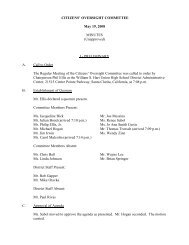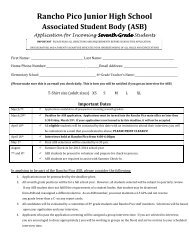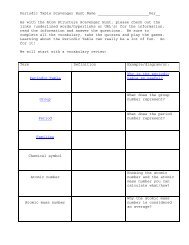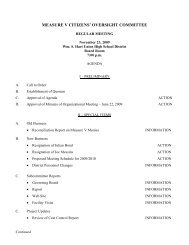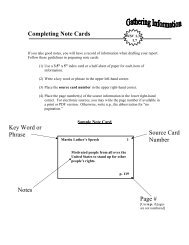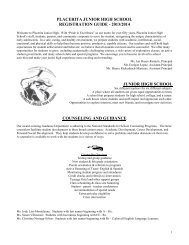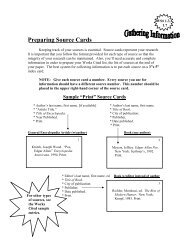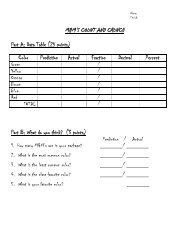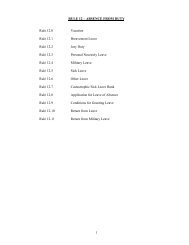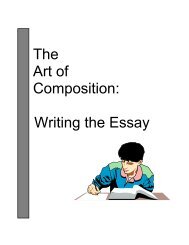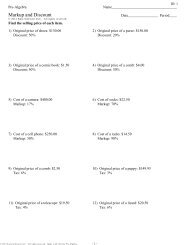Safe School Plan - William S. Hart Union High School District
Safe School Plan - William S. Hart Union High School District
Safe School Plan - William S. Hart Union High School District
You also want an ePaper? Increase the reach of your titles
YUMPU automatically turns print PDFs into web optimized ePapers that Google loves.
4. Limit intake of alcoholic beverages. Although most sodas, beer and other alcoholic beverages appear to satisfy thirst, they actually cause<br />
further body dehydration.<br />
5. Never leave children or pets alone in closed vehicles.<br />
6. Dress in loose fitting clothes that cover as much skin as possible.<br />
Lightweight, light-colored clothing reflects heat and sunlight and helps maintain normal body temperature.<br />
7. Protect face and head by wearing a wide-brimmed hat.<br />
8. Avoid too much sunshine.<br />
Sunburn slows the skin’s ability to cool itself. Use a sunscreen lotion with a high SPF (sun protection factor) rating (i.e., 15 or<br />
greater).<br />
9. Avoid strenuous work during the warmest part of the day. Use a buddy system when working in extreme heat and take frequent breaks.<br />
10. Spend at least two hours per day in an air-conditioned place. If your home is not air conditioned, consider spending the warmest part of<br />
the day in public buildings such as libraries, schools, movie theaters, shopping malls and other community facilities.<br />
11. Check on family, friends, and neighbors who do not have air conditioning and who spend much of their time alone.<br />
First-aid for heat-induced illnesses<br />
1. Sunburn<br />
Symptoms: Skin redness and pain, possible swelling, blisters, fever, headaches.<br />
First Aid: Take a shower, using soap, to remove oils that may block pores, preventing the body from cooling naturally. If blisters<br />
occur, apply dry, sterile dressings and get medical attention.<br />
2. Heat cramps<br />
Symptoms: Painful spasms, usually in leg and abdominal muscles. Heavy sweating.<br />
First Aid: Get the victim out to a cooler location. Lightly stretch and gently massage affected muscles to relieve spasm. Give sips of<br />
up to a half glass of cool water every 15 minutes. Do not give liquids with caffeine or alcohol. If nauseous, discontinue liquids.<br />
3. Heat exhaustion<br />
Symptoms: Heavy sweating and skin may be cool, pale or flushed. Weak pulse. Normal body temperature is possible but temperature<br />
will likely rise. Fainting or dizziness, nausea or vomiting, exhaustion and headaches are possible.<br />
First Aid: Get victim to lie down in a cool place. Loosen or remove clothing. Apply cool, wet cloths. Fan or move victim to airconditioned<br />
place. Give sips of water if victim is conscious. Be sure water is consumed slowly. Give half glass of cool water every 15<br />
minutes. If nausea occurs, discontinue. If vomiting occurs, seek immediate medical attention.<br />
4. Heat stroke (sun stroke)<br />
Symptoms: <strong>High</strong> body temperature<br />
(105+). Hot, red, dry skin. Rapid, weak pulse; and rapid, shallow breathing. Possible unconsciousness. Victim will likely not sweat<br />
unless victim was sweating from recent strenuous activity.<br />
First Aid: Heat stroke is a severe medical emergency. Call 911 or emergency medical services or get the victim to a hospital<br />
immediately. Delay can be fatal. Move victim to a cooler environment. Remove clothing. Try a cool bath, sponging or wet sheet<br />
to reduce body temperature. Watch for breathing problems. Use extreme caution. Use fans and air conditioners.<br />
89




